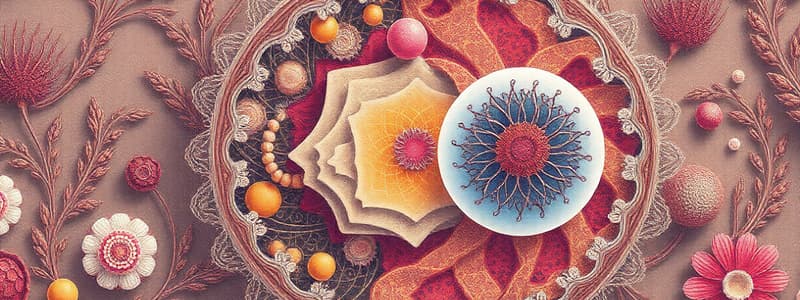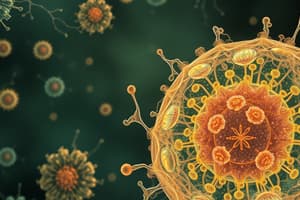Podcast
Questions and Answers
Which of the following is NOT a tenet of the cell theory?
Which of the following is NOT a tenet of the cell theory?
- All cells come from other, pre-existing cells.
- All cells have a nucleus. (correct)
- Cells are the smallest living unit in all organisms.
- All living things are made of cells.
Prokaryotic cells contain membrane-bound organelles.
Prokaryotic cells contain membrane-bound organelles.
False (B)
What is the main function of ribosomes?
What is the main function of ribosomes?
protein synthesis
The ______ is the control center of the cell and contains the genetic material (DNA).
The ______ is the control center of the cell and contains the genetic material (DNA).
Match the following organelles with their primary function:
Match the following organelles with their primary function:
Which of the following is found in both prokaryotic and eukaryotic cells?
Which of the following is found in both prokaryotic and eukaryotic cells?
The cytoplasm is the gel-like substance that fills the nucleus.
The cytoplasm is the gel-like substance that fills the nucleus.
What is the role of the cell membrane?
What is the role of the cell membrane?
Which of the following organelles is responsible for photosynthesis?
Which of the following organelles is responsible for photosynthesis?
Animal cells contain a large central vacuole.
Animal cells contain a large central vacuole.
What molecule contains the instructions for protein production?
What molecule contains the instructions for protein production?
Proteins targeted for secretion are packaged into vesicles and transported to the cell ______ to be released outside the cell.
Proteins targeted for secretion are packaged into vesicles and transported to the cell ______ to be released outside the cell.
Match the following organelles with their functions:
Match the following organelles with their functions:
Flashcards
Cell Theory
Cell Theory
A fundamental theory stating that cells are the basic unit of life, all living things are made of cells, and all cells arise from pre-existing cells.
Prokaryotes
Prokaryotes
Simple cells without a nucleus or membrane-bound organelles, including bacteria and archaea.
Eukaryotes
Eukaryotes
Complex cells with a nucleus and membrane-bound organelles, including plants, animals, fungi, and protists.
Cell Membrane
Cell Membrane
Signup and view all the flashcards
Cytoplasm
Cytoplasm
Signup and view all the flashcards
Nucleus
Nucleus
Signup and view all the flashcards
Mitochondria
Mitochondria
Signup and view all the flashcards
Golgi Apparatus
Golgi Apparatus
Signup and view all the flashcards
Chloroplasts
Chloroplasts
Signup and view all the flashcards
Vacuoles
Vacuoles
Signup and view all the flashcards
Cell Wall
Cell Wall
Signup and view all the flashcards
Protein Synthesis
Protein Synthesis
Signup and view all the flashcards
Study Notes
Introduction
- The video discusses the cell theory and examines the characteristics of prokaryotic and eukaryotic cells.
- The video uses an example of the amoeba, a single-celled organism, to illustrate the importance of cells in biology.
- The cell theory is crucial:
- Cells are the smallest living unit in all organisms.
- All living things are made of cells.
- All cells come from pre-existing cells.
Prokaryotes and Eukaryotes
- Prokaryotes lack a nucleus and membrane-bound organelles.
- Eukaryotes have a nucleus and membrane-bound organelles.
- Prokaryotes include bacteria and archaea.
- Eukaryotes include plants, animals, fungi, and protists.
- Both prokaryotes and eukaryotes share common features:
- Both contain genetic material.
- Both have cytoplasm.
- Both have ribosomes, which synthesize proteins.
- Both have cell membranes that control what enters and exits the cell.
Organelles Found in Eukaryotes
- Key eukaryotic organelles and their functions:
- Cell Membrane (Plasma Membrane): Controls substance movement, maintaining homeostasis.
- Cytoplasm: Jelly-like substance filling the cell, surrounding organelles.
- Cytoskeleton: Provides structural support, aids movement, and organizes organelles.
- Ribosomes: Synthesize proteins; found free or attached to ER.
- Nucleus: The control center, containing DNA and a nucleolus (ribosome production).
- Endoplasmic Reticulum (ER): Processes and transports molecules; rough ER (with ribosomes) and smooth ER (without ribosomes).
- Golgi Apparatus: Packages, sorts, and modifies molecules for delivery.
- Mitochondria: "Powerhouses" of the cell; produce ATP energy through cellular respiration using glucose and oxygen.
- Chloroplasts (in plants): Perform photosynthesis, converting light energy, CO2, and water into glucose and oxygen.
- Vacuoles: Storage compartments; plant cells often have a large central vacuole.
- Cell Wall (in plants): Provides structural support and protection (absent in animal cells).
Protein Synthesis and Transport
- Protein creation and movement in cells:
- DNA holds the protein production instructions.
- Ribosomes read DNA instructions to create proteins.
- Ribosomes on rough ER synthesize proteins for transport through the ER.
- Proteins packaged into vesicles travel to the Golgi.
- The Golgi modifies and sorts proteins.
- Proteins for secretion are packaged into vesicles to the cell membrane; released from the cell.
Studying That Suits You
Use AI to generate personalized quizzes and flashcards to suit your learning preferences.




